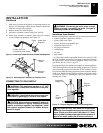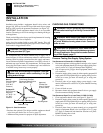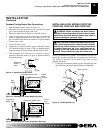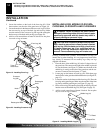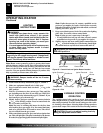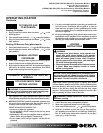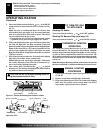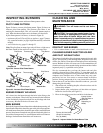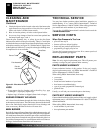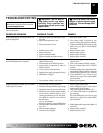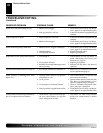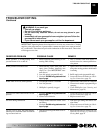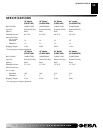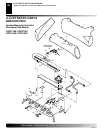
107068-01D
For more information, visit www.desatech.com
For more information, visit www.desatech.com
19
19
INSPECTING BURNERS
Pilot Flame Pattern
Burner Primary Air Holes
Main Burner
CLEANING AND MAINTENANCE
ODS/Pilot And Burner
Cleaning Burner Injector Holder and Pilot Air Inlet Hole
BURNER PRIMARY AIR HOLES
Air is drawn into the burner through the holes in the fitting at the
entrance to the burner. These holes may become blocked with dust
or lint. Periodically inspect these holes for any blockage and clean
as necessary. Blocked air holes will create soot.
MAIN BURNER
Periodically inspect all burner flame holes with the heater running. All
slotted burner flame holes should be open with yellow flame present.
All round burner flame holes should be open with a small blue flame
present. Some burner flame holes may become blocked by debris or
rust, with no flame present. If so, turn off heater and let cool. Remove
blockage, blocked burner flame holes will create soot.
INSPECTING BURNERS
Check pilot flame pattern and burner flame patterns often.
PILOT FLAME PATTERN
Figure 29 shows a correct pilot flame pattern. Figure 30 shows an
incorrect pilot flame pattern. The incorrect pilot flame is not
touching the thermocouple. This will cause the thermocouple to
cool. When the thermocouple cools, the heater will shut down.
If pilot flame pattern is incorrect, as shown in Figure 30
• turn heater off (see To Turn Off Gas to Appliance, page 17 [manu-
ally-controlled models] or page 18 [thermostatically-controlled
model])
• see Troubleshooting, pages 21 through 23
Note:
The pilot flame on natural gas units will have a slight curve,
but flame should be blue and have no yellow or orange color.
Figure 29 - Correct Pilot Flame Pattern
Figure 30 - Incorrect Pilot Flame Pattern
Thermocouple
Pilot Burner
Thermocouple
Pilot Burner
Thermocouple
Pilot Burner
Thermocouple
Pilot Burner
CLEANING AND
MAINTENANCE
WARNING: Turn off heater and let cool before
cleaning.
CAUTION: You must keep control areas, burner,
and circulating air passageways of heater clean. In-
spect these areas of heater before each use. Have
heater inspected yearly by a qualified service person.
Heater may need more frequent cleaning due to exces-
sive lint from carpeting, bedding material, pet hair, etc.
ODS/PILOT AND BURNER
• Use a vacuum cleaner or small, soft bristled brush to clean.
CLEANING BURNER INJECTOR HOLDER
AND PILOT AIR INLET HOLE
The primary air inlet holes allow the proper amount of air to mix with
the gas. This provides a clean burning flame. Keep these holes clear
of dust, dirt, and lint. Clean these air inlet holes prior to each heating
season. Blocked air holes will create soot. We recommend that you
clean the unit every three months during operation and have heater
inspected yearly by a qualified service person.
We also recommend that you keep the burner tube and pilot
assembly clean and free of dust and dirt. To clean these parts we
recommend using compressed air no greater than 30 PSI. Your local
computer store, hardware store, or home center may carry com-
pressed air in a can. You can use a vacuum cleaner in the blow
position. If using compressed air in a can, please follow the direc-
tions on the can. If you don't follow directions on the can, you could
damage the pilot assembly.
1. Shut off the unit, including the pilot. Allow the unit to cool for
at least thirty minutes.
2. Inspect burner, pilot, and primary air inlet holes on injector
holder for dust and dirt (see Figure 31).
3. Blow air through the ports/slots and holes in the burner.
Figure 31 - Injector Holder On Outlet Burner Tube
Burner Tube
Primary Air Inlet Holes
(Shape of Holes May
Vary by Model)
Injector Holder
(May Be Brass or
Aluminum
Depending on
Model)
Propane/LP
Natural Gas
Propane/LP
Natural Gas



